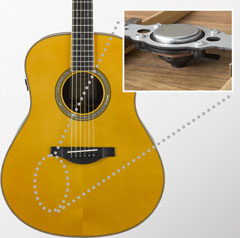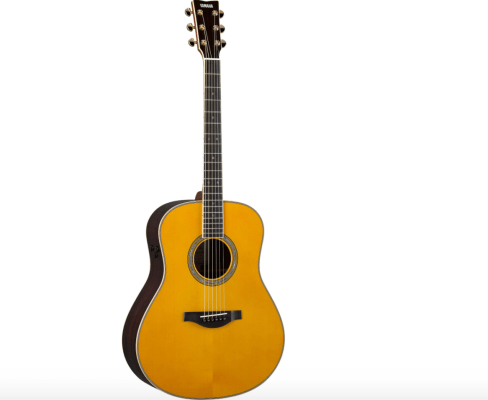“Well you’re in your little room,” wrote the bard. “And you’re working on something good. But if it’s really good you’re gonna need a bigger room.” With the Yamaha LL-TA you can have just that.
The $1,600 Yamaha LL-TA – the TA stands for Transacoustic – is an acoustic guitar with a built-in effects processor and actuator that augments the sound of the strings. Inside the body of the guitar, hidden on one side, is an effects generator and strapped to the front is a transducer that changes the sound as you play. You can turn it off and on at will and even route the sound to a line-out in the endpin next to the double AA battery pack.
To “activate” the effects you touch one of the unobtrusive buttons on the top side of the guitar. The entire system is silent – the only indication that it is working comes from a lone green light inside the guitar body. Very quickly, however, the chorus and reverb kick in and you’re transported on a magic carpet ride to James Taylor-town.
 The sound is impressive. To get a silvery, rippling reverb and chorus out of an unplugged acoustic guitar is pretty exciting. Imagine an electric guitar with a built-in Marshall stack and overdrive unit – all inside the thin body of a Strat – and you kind of get the idea: you can get natural sounds out of this guitar that would usually require a few hundred dollars of gear to recreate. The actuator on the front of the body reacts to the sounds of the strings, expanding them without sounding like the sound is being piped through a speaker.
The sound is impressive. To get a silvery, rippling reverb and chorus out of an unplugged acoustic guitar is pretty exciting. Imagine an electric guitar with a built-in Marshall stack and overdrive unit – all inside the thin body of a Strat – and you kind of get the idea: you can get natural sounds out of this guitar that would usually require a few hundred dollars of gear to recreate. The actuator on the front of the body reacts to the sounds of the strings, expanding them without sounding like the sound is being piped through a speaker.
The following is a quick test I ran. The first part is with the TA off completely and then the last two bits are with TA on.
I found it very pleasant to play and the effects added a bit of creativity to my plinking. I’m not a great guitarist by any stretch but this was plain fun.
Why do you want a guitar like this? First it gets rid of bulky chorus and reverb pedals. While you won’t be recreating Stairway in its glorious entirety with this thing you can get a nice approximation of the early acoustic parts. Yamaha makes a good guitar in the first place and this one is based on the Original Jumbo body and the workmanship and woods are a delight. Turning on the effects is just icing on a guitar cake.
But, for some, the LL-TA is truly an odd duck and a hard sell. The reverb and chorus, when they kick in after a bit of fingerpicking, sound amazing especially considering they are not actively connected to an amp, effects, or speakers. You can add a great deal of depth and brightness with just a single button tap. But why?
Most musicians want a clean sound from their guitar, a special sound from the effects, and a clean sound from the amp/speaker. Embedding the effects into a guitar, while cool, might be seen as a gimmick. However, given that the Yamaha is a solid workhorse guitar and the effects don’t take up any space in your gig bag it could be a good busker’s guitar, a good singer-songwriter axe, or a nice way to add a little sparkle to your demos and recordings.
The LL-TA is not a Keytar. It’s not a MIDI device. It’s basically an acoustic guitar that can sound like a nicely augmented electro-acoustic. Because the modeling is literally internal to the body you avoid a lot of the plinky sounds associated with acoustic-electrics and it means you can get some nice tones without much gear.
To be clear $1,600 for a Yamaha is a bit of a stretch but it’s a clever add-on to a nice guitar and you will be amazed when you hear your rendition of “No Woman No Cry” sound like an ethereal reverb-rich whale call the way Bob Marley intended.
